Laboratory Report on Chromatographic Techniques
VerifiedAdded on 2022/09/02
|7
|1881
|24
AI Summary
Contribute Materials
Your contribution can guide someone’s learning journey. Share your
documents today.
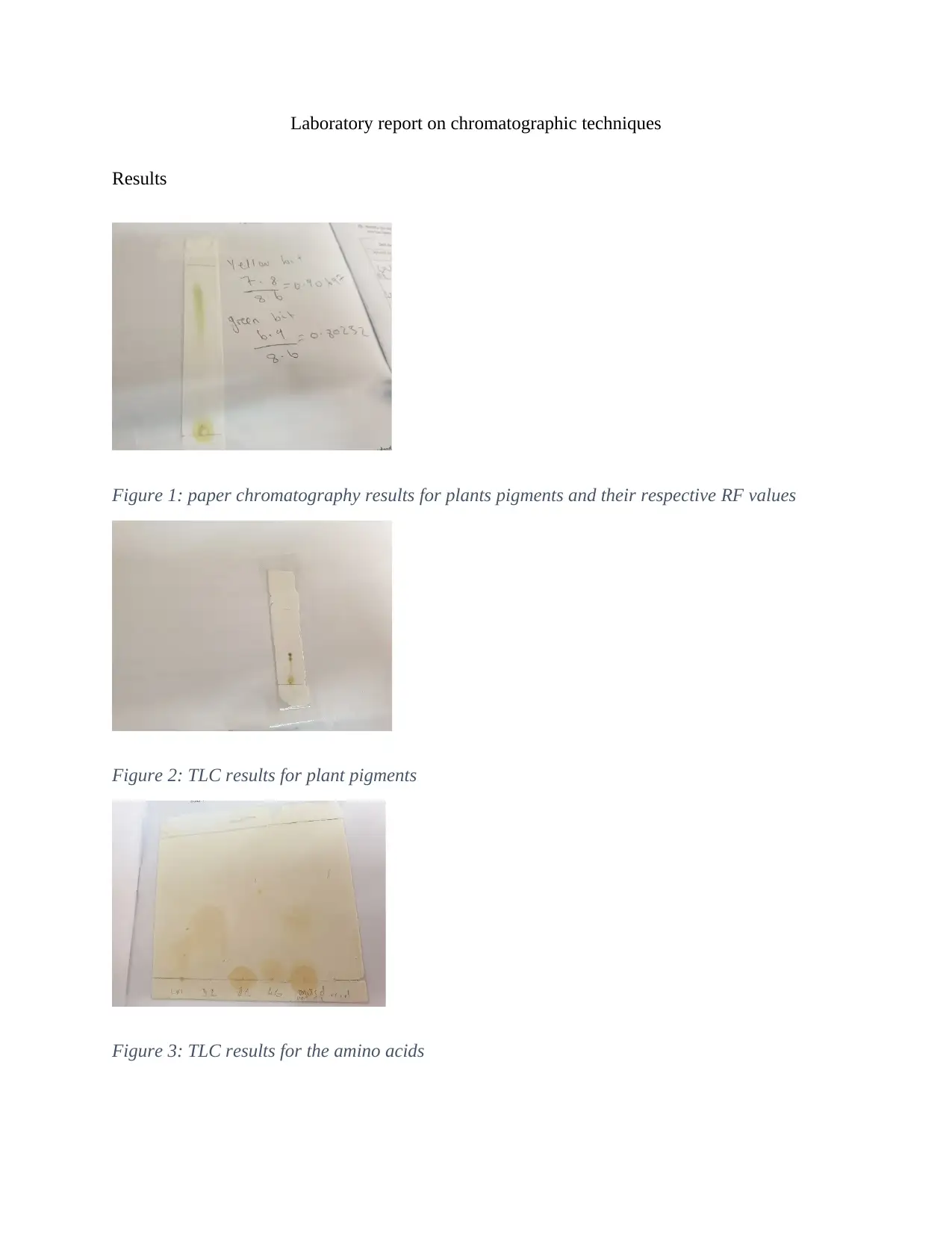
Laboratory report on chromatographic techniques
Results
Figure 1: paper chromatography results for plants pigments and their respective RF values
Figure 2: TLC results for plant pigments
Figure 3: TLC results for the amino acids
Results
Figure 1: paper chromatography results for plants pigments and their respective RF values
Figure 2: TLC results for plant pigments
Figure 3: TLC results for the amino acids
Secure Best Marks with AI Grader
Need help grading? Try our AI Grader for instant feedback on your assignments.
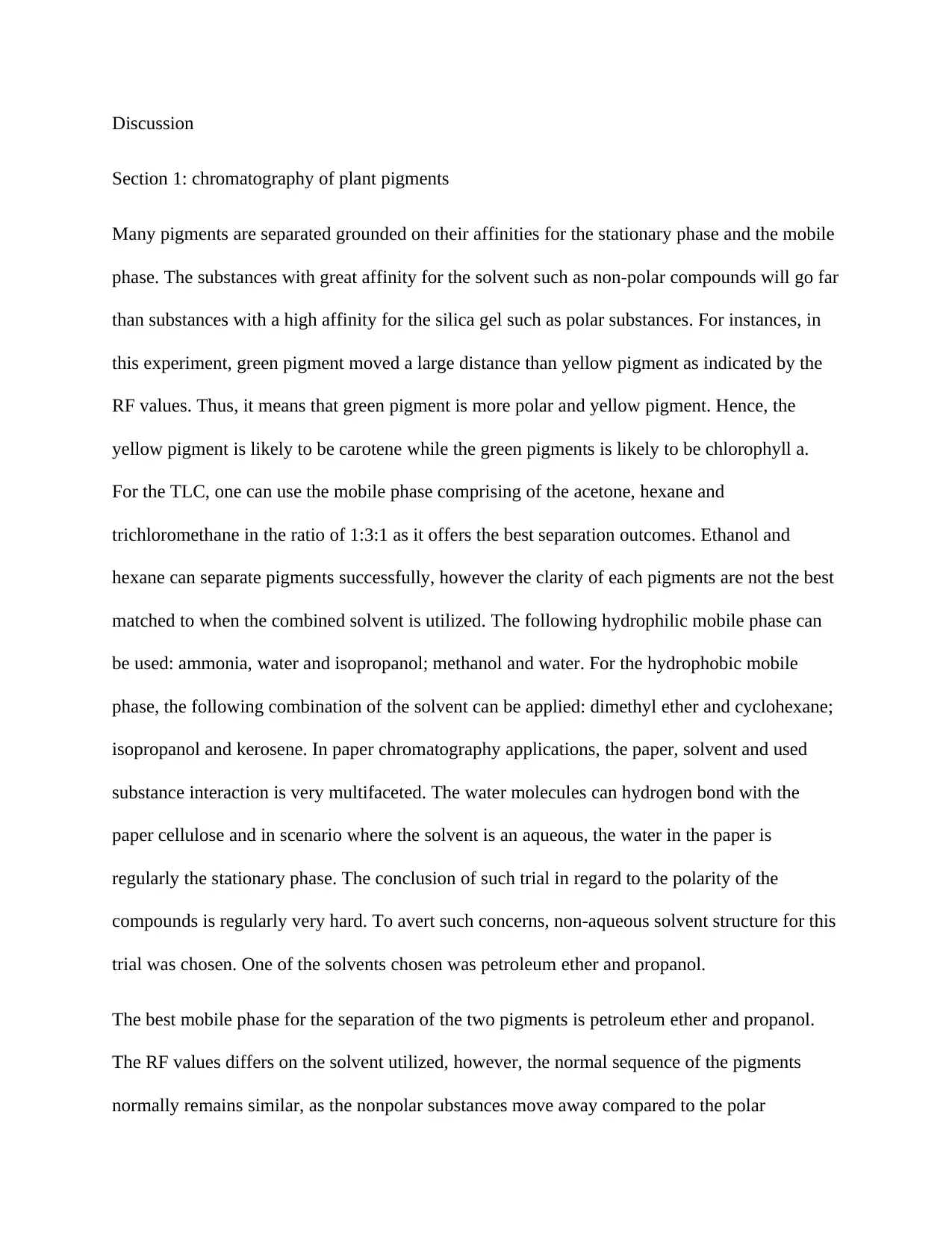
Discussion
Section 1: chromatography of plant pigments
Many pigments are separated grounded on their affinities for the stationary phase and the mobile
phase. The substances with great affinity for the solvent such as non-polar compounds will go far
than substances with a high affinity for the silica gel such as polar substances. For instances, in
this experiment, green pigment moved a large distance than yellow pigment as indicated by the
RF values. Thus, it means that green pigment is more polar and yellow pigment. Hence, the
yellow pigment is likely to be carotene while the green pigments is likely to be chlorophyll a.
For the TLC, one can use the mobile phase comprising of the acetone, hexane and
trichloromethane in the ratio of 1:3:1 as it offers the best separation outcomes. Ethanol and
hexane can separate pigments successfully, however the clarity of each pigments are not the best
matched to when the combined solvent is utilized. The following hydrophilic mobile phase can
be used: ammonia, water and isopropanol; methanol and water. For the hydrophobic mobile
phase, the following combination of the solvent can be applied: dimethyl ether and cyclohexane;
isopropanol and kerosene. In paper chromatography applications, the paper, solvent and used
substance interaction is very multifaceted. The water molecules can hydrogen bond with the
paper cellulose and in scenario where the solvent is an aqueous, the water in the paper is
regularly the stationary phase. The conclusion of such trial in regard to the polarity of the
compounds is regularly very hard. To avert such concerns, non-aqueous solvent structure for this
trial was chosen. One of the solvents chosen was petroleum ether and propanol.
The best mobile phase for the separation of the two pigments is petroleum ether and propanol.
The RF values differs on the solvent utilized, however, the normal sequence of the pigments
normally remains similar, as the nonpolar substances move away compared to the polar
Section 1: chromatography of plant pigments
Many pigments are separated grounded on their affinities for the stationary phase and the mobile
phase. The substances with great affinity for the solvent such as non-polar compounds will go far
than substances with a high affinity for the silica gel such as polar substances. For instances, in
this experiment, green pigment moved a large distance than yellow pigment as indicated by the
RF values. Thus, it means that green pigment is more polar and yellow pigment. Hence, the
yellow pigment is likely to be carotene while the green pigments is likely to be chlorophyll a.
For the TLC, one can use the mobile phase comprising of the acetone, hexane and
trichloromethane in the ratio of 1:3:1 as it offers the best separation outcomes. Ethanol and
hexane can separate pigments successfully, however the clarity of each pigments are not the best
matched to when the combined solvent is utilized. The following hydrophilic mobile phase can
be used: ammonia, water and isopropanol; methanol and water. For the hydrophobic mobile
phase, the following combination of the solvent can be applied: dimethyl ether and cyclohexane;
isopropanol and kerosene. In paper chromatography applications, the paper, solvent and used
substance interaction is very multifaceted. The water molecules can hydrogen bond with the
paper cellulose and in scenario where the solvent is an aqueous, the water in the paper is
regularly the stationary phase. The conclusion of such trial in regard to the polarity of the
compounds is regularly very hard. To avert such concerns, non-aqueous solvent structure for this
trial was chosen. One of the solvents chosen was petroleum ether and propanol.
The best mobile phase for the separation of the two pigments is petroleum ether and propanol.
The RF values differs on the solvent utilized, however, the normal sequence of the pigments
normally remains similar, as the nonpolar substances move away compared to the polar
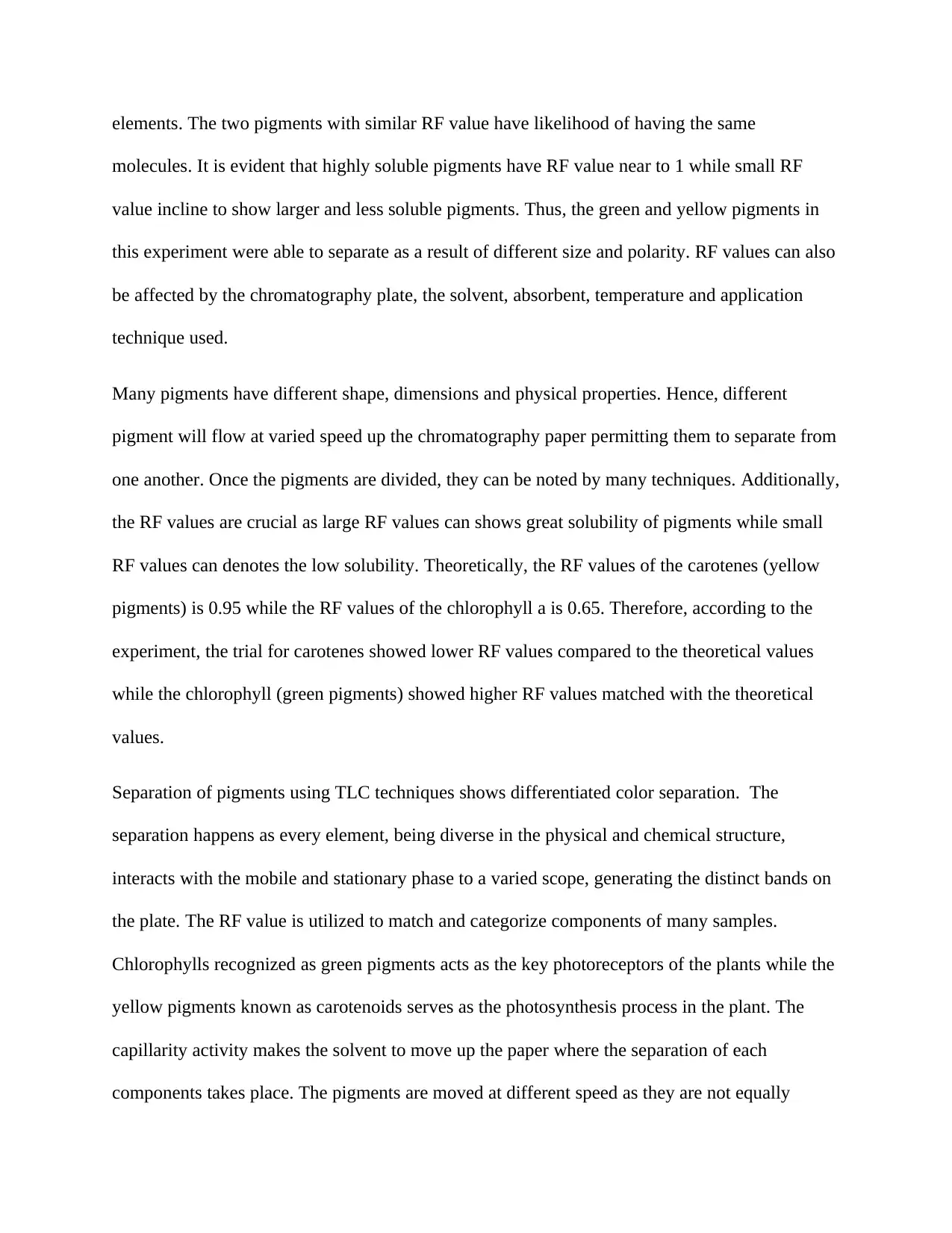
elements. The two pigments with similar RF value have likelihood of having the same
molecules. It is evident that highly soluble pigments have RF value near to 1 while small RF
value incline to show larger and less soluble pigments. Thus, the green and yellow pigments in
this experiment were able to separate as a result of different size and polarity. RF values can also
be affected by the chromatography plate, the solvent, absorbent, temperature and application
technique used.
Many pigments have different shape, dimensions and physical properties. Hence, different
pigment will flow at varied speed up the chromatography paper permitting them to separate from
one another. Once the pigments are divided, they can be noted by many techniques. Additionally,
the RF values are crucial as large RF values can shows great solubility of pigments while small
RF values can denotes the low solubility. Theoretically, the RF values of the carotenes (yellow
pigments) is 0.95 while the RF values of the chlorophyll a is 0.65. Therefore, according to the
experiment, the trial for carotenes showed lower RF values compared to the theoretical values
while the chlorophyll (green pigments) showed higher RF values matched with the theoretical
values.
Separation of pigments using TLC techniques shows differentiated color separation. The
separation happens as every element, being diverse in the physical and chemical structure,
interacts with the mobile and stationary phase to a varied scope, generating the distinct bands on
the plate. The RF value is utilized to match and categorize components of many samples.
Chlorophylls recognized as green pigments acts as the key photoreceptors of the plants while the
yellow pigments known as carotenoids serves as the photosynthesis process in the plant. The
capillarity activity makes the solvent to move up the paper where the separation of each
components takes place. The pigments are moved at different speed as they are not equally
molecules. It is evident that highly soluble pigments have RF value near to 1 while small RF
value incline to show larger and less soluble pigments. Thus, the green and yellow pigments in
this experiment were able to separate as a result of different size and polarity. RF values can also
be affected by the chromatography plate, the solvent, absorbent, temperature and application
technique used.
Many pigments have different shape, dimensions and physical properties. Hence, different
pigment will flow at varied speed up the chromatography paper permitting them to separate from
one another. Once the pigments are divided, they can be noted by many techniques. Additionally,
the RF values are crucial as large RF values can shows great solubility of pigments while small
RF values can denotes the low solubility. Theoretically, the RF values of the carotenes (yellow
pigments) is 0.95 while the RF values of the chlorophyll a is 0.65. Therefore, according to the
experiment, the trial for carotenes showed lower RF values compared to the theoretical values
while the chlorophyll (green pigments) showed higher RF values matched with the theoretical
values.
Separation of pigments using TLC techniques shows differentiated color separation. The
separation happens as every element, being diverse in the physical and chemical structure,
interacts with the mobile and stationary phase to a varied scope, generating the distinct bands on
the plate. The RF value is utilized to match and categorize components of many samples.
Chlorophylls recognized as green pigments acts as the key photoreceptors of the plants while the
yellow pigments known as carotenoids serves as the photosynthesis process in the plant. The
capillarity activity makes the solvent to move up the paper where the separation of each
components takes place. The pigments are moved at different speed as they are not equally
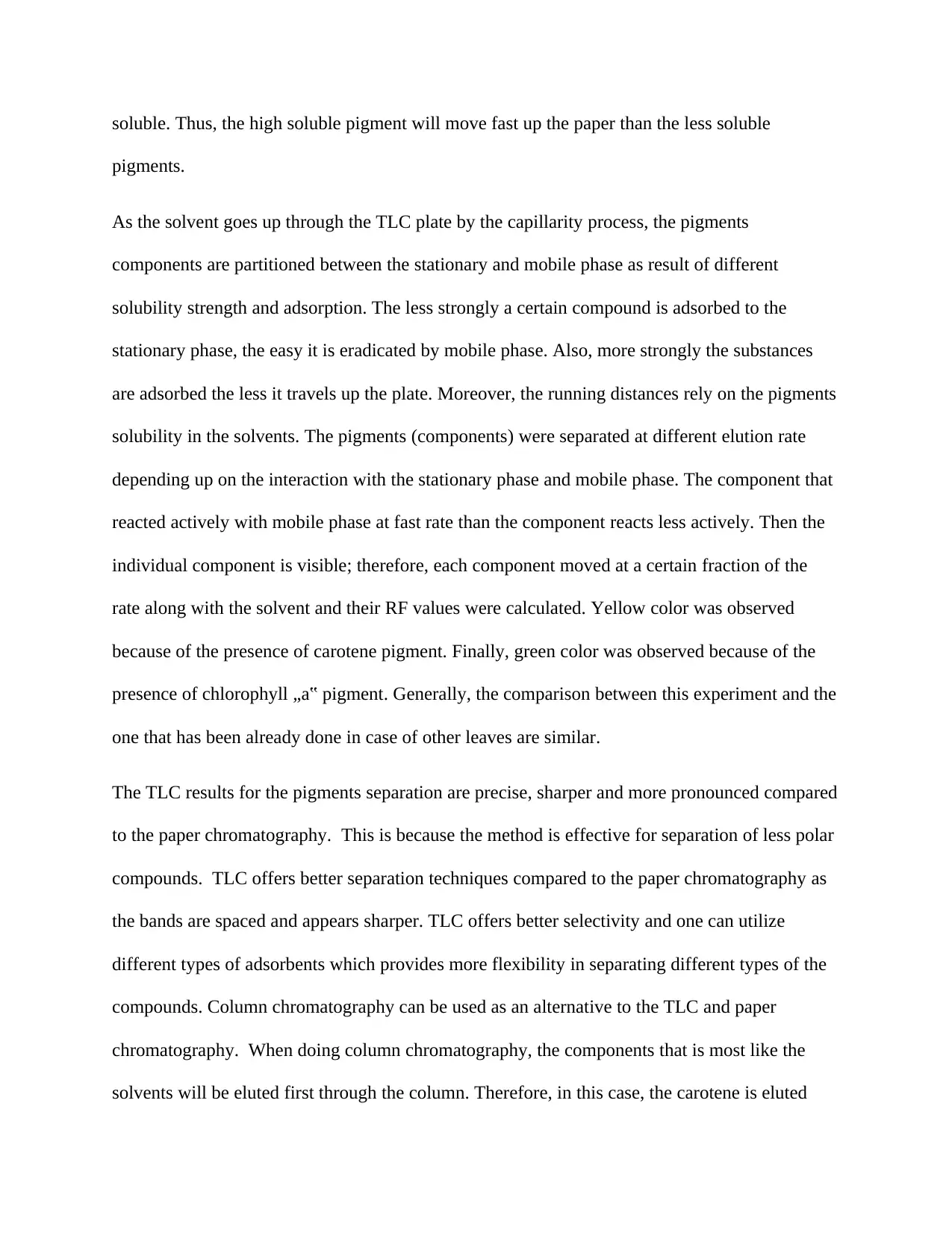
soluble. Thus, the high soluble pigment will move fast up the paper than the less soluble
pigments.
As the solvent goes up through the TLC plate by the capillarity process, the pigments
components are partitioned between the stationary and mobile phase as result of different
solubility strength and adsorption. The less strongly a certain compound is adsorbed to the
stationary phase, the easy it is eradicated by mobile phase. Also, more strongly the substances
are adsorbed the less it travels up the plate. Moreover, the running distances rely on the pigments
solubility in the solvents. The pigments (components) were separated at different elution rate
depending up on the interaction with the stationary phase and mobile phase. The component that
reacted actively with mobile phase at fast rate than the component reacts less actively. Then the
individual component is visible; therefore, each component moved at a certain fraction of the
rate along with the solvent and their RF values were calculated. Yellow color was observed
because of the presence of carotene pigment. Finally, green color was observed because of the
presence of chlorophyll „a‟ pigment. Generally, the comparison between this experiment and the
one that has been already done in case of other leaves are similar.
The TLC results for the pigments separation are precise, sharper and more pronounced compared
to the paper chromatography. This is because the method is effective for separation of less polar
compounds. TLC offers better separation techniques compared to the paper chromatography as
the bands are spaced and appears sharper. TLC offers better selectivity and one can utilize
different types of adsorbents which provides more flexibility in separating different types of the
compounds. Column chromatography can be used as an alternative to the TLC and paper
chromatography. When doing column chromatography, the components that is most like the
solvents will be eluted first through the column. Therefore, in this case, the carotene is eluted
pigments.
As the solvent goes up through the TLC plate by the capillarity process, the pigments
components are partitioned between the stationary and mobile phase as result of different
solubility strength and adsorption. The less strongly a certain compound is adsorbed to the
stationary phase, the easy it is eradicated by mobile phase. Also, more strongly the substances
are adsorbed the less it travels up the plate. Moreover, the running distances rely on the pigments
solubility in the solvents. The pigments (components) were separated at different elution rate
depending up on the interaction with the stationary phase and mobile phase. The component that
reacted actively with mobile phase at fast rate than the component reacts less actively. Then the
individual component is visible; therefore, each component moved at a certain fraction of the
rate along with the solvent and their RF values were calculated. Yellow color was observed
because of the presence of carotene pigment. Finally, green color was observed because of the
presence of chlorophyll „a‟ pigment. Generally, the comparison between this experiment and the
one that has been already done in case of other leaves are similar.
The TLC results for the pigments separation are precise, sharper and more pronounced compared
to the paper chromatography. This is because the method is effective for separation of less polar
compounds. TLC offers better separation techniques compared to the paper chromatography as
the bands are spaced and appears sharper. TLC offers better selectivity and one can utilize
different types of adsorbents which provides more flexibility in separating different types of the
compounds. Column chromatography can be used as an alternative to the TLC and paper
chromatography. When doing column chromatography, the components that is most like the
solvents will be eluted first through the column. Therefore, in this case, the carotene is eluted
Secure Best Marks with AI Grader
Need help grading? Try our AI Grader for instant feedback on your assignments.
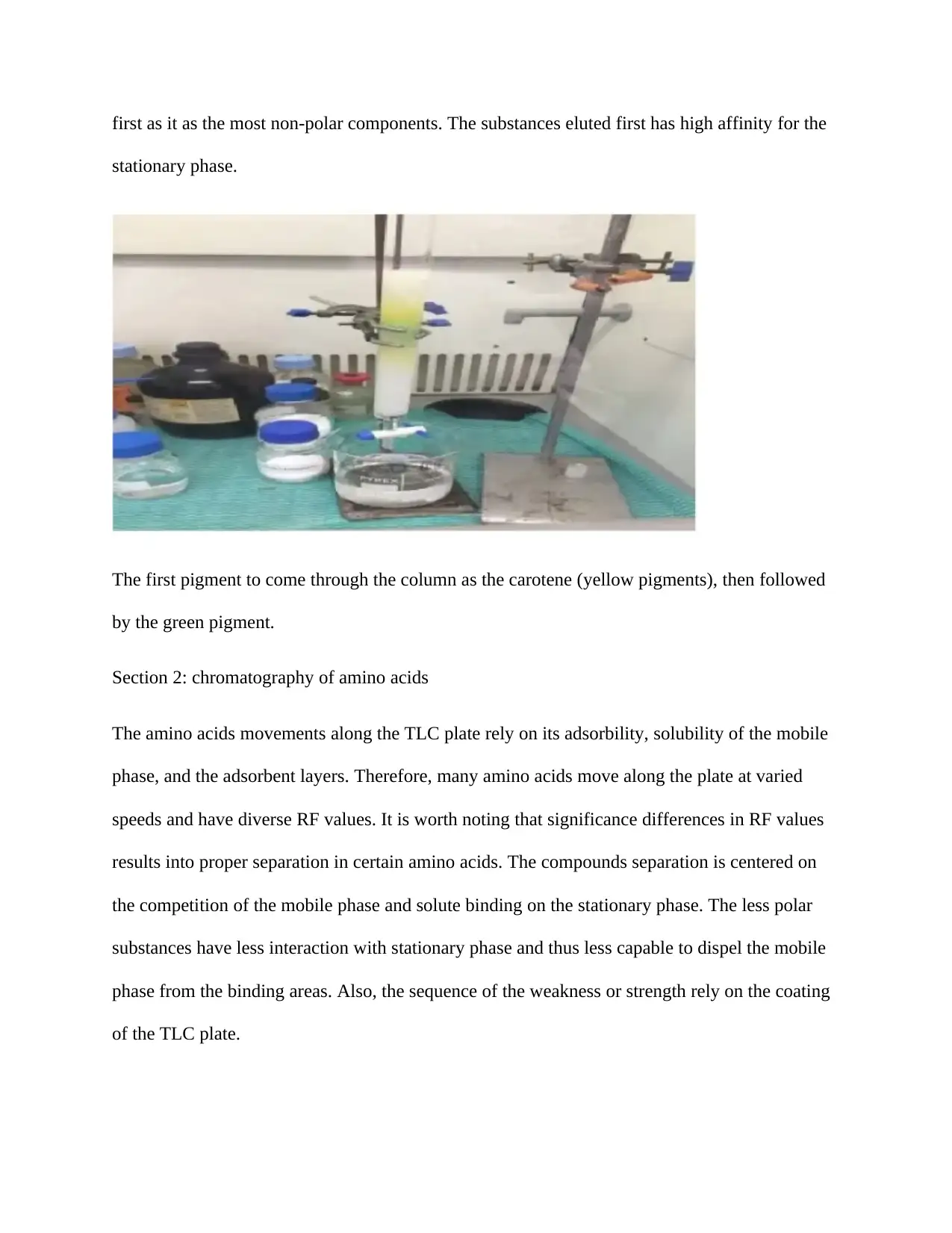
first as it as the most non-polar components. The substances eluted first has high affinity for the
stationary phase.
The first pigment to come through the column as the carotene (yellow pigments), then followed
by the green pigment.
Section 2: chromatography of amino acids
The amino acids movements along the TLC plate rely on its adsorbility, solubility of the mobile
phase, and the adsorbent layers. Therefore, many amino acids move along the plate at varied
speeds and have diverse RF values. It is worth noting that significance differences in RF values
results into proper separation in certain amino acids. The compounds separation is centered on
the competition of the mobile phase and solute binding on the stationary phase. The less polar
substances have less interaction with stationary phase and thus less capable to dispel the mobile
phase from the binding areas. Also, the sequence of the weakness or strength rely on the coating
of the TLC plate.
stationary phase.
The first pigment to come through the column as the carotene (yellow pigments), then followed
by the green pigment.
Section 2: chromatography of amino acids
The amino acids movements along the TLC plate rely on its adsorbility, solubility of the mobile
phase, and the adsorbent layers. Therefore, many amino acids move along the plate at varied
speeds and have diverse RF values. It is worth noting that significance differences in RF values
results into proper separation in certain amino acids. The compounds separation is centered on
the competition of the mobile phase and solute binding on the stationary phase. The less polar
substances have less interaction with stationary phase and thus less capable to dispel the mobile
phase from the binding areas. Also, the sequence of the weakness or strength rely on the coating
of the TLC plate.
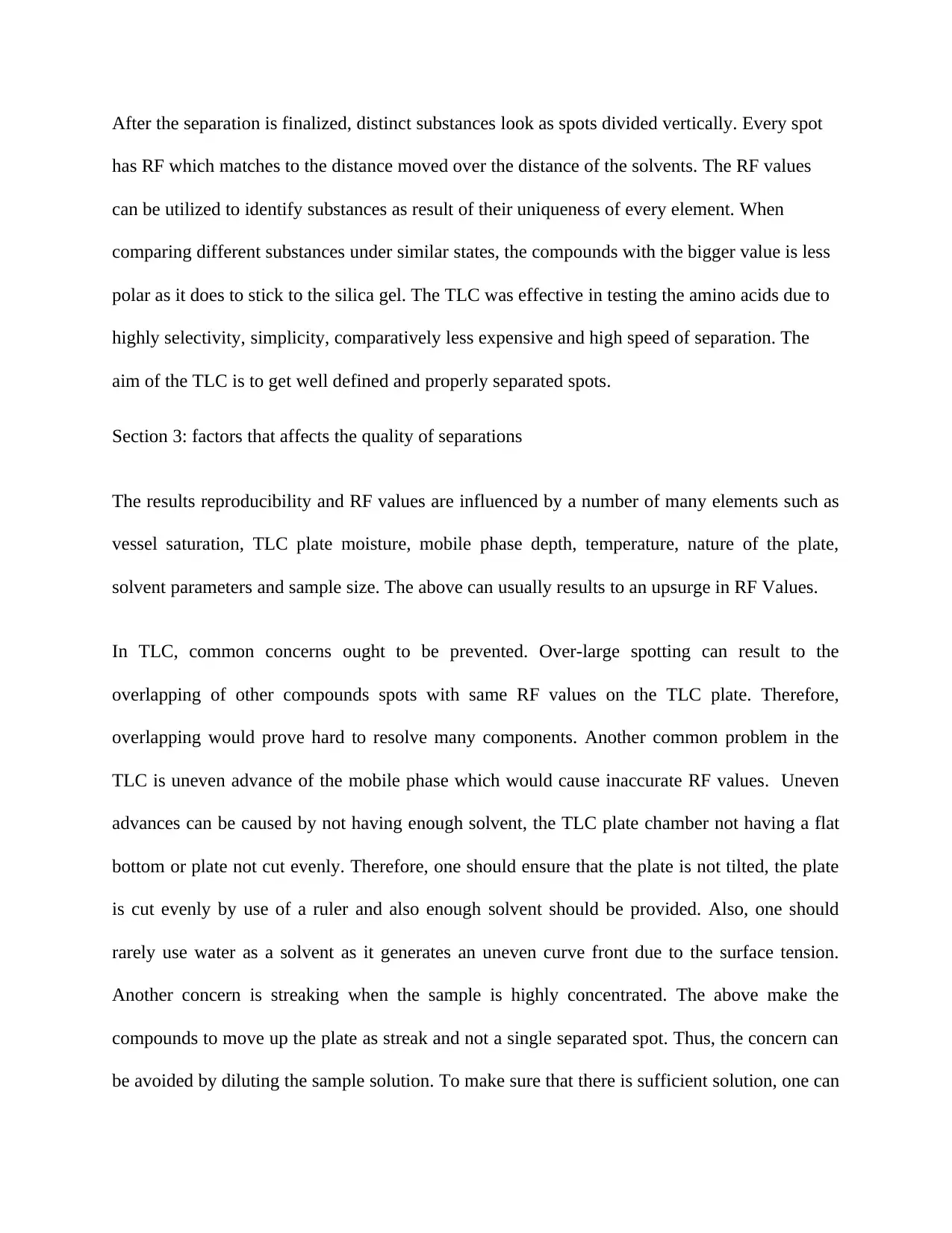
After the separation is finalized, distinct substances look as spots divided vertically. Every spot
has RF which matches to the distance moved over the distance of the solvents. The RF values
can be utilized to identify substances as result of their uniqueness of every element. When
comparing different substances under similar states, the compounds with the bigger value is less
polar as it does to stick to the silica gel. The TLC was effective in testing the amino acids due to
highly selectivity, simplicity, comparatively less expensive and high speed of separation. The
aim of the TLC is to get well defined and properly separated spots.
Section 3: factors that affects the quality of separations
The results reproducibility and RF values are influenced by a number of many elements such as
vessel saturation, TLC plate moisture, mobile phase depth, temperature, nature of the plate,
solvent parameters and sample size. The above can usually results to an upsurge in RF Values.
In TLC, common concerns ought to be prevented. Over-large spotting can result to the
overlapping of other compounds spots with same RF values on the TLC plate. Therefore,
overlapping would prove hard to resolve many components. Another common problem in the
TLC is uneven advance of the mobile phase which would cause inaccurate RF values. Uneven
advances can be caused by not having enough solvent, the TLC plate chamber not having a flat
bottom or plate not cut evenly. Therefore, one should ensure that the plate is not tilted, the plate
is cut evenly by use of a ruler and also enough solvent should be provided. Also, one should
rarely use water as a solvent as it generates an uneven curve front due to the surface tension.
Another concern is streaking when the sample is highly concentrated. The above make the
compounds to move up the plate as streak and not a single separated spot. Thus, the concern can
be avoided by diluting the sample solution. To make sure that there is sufficient solution, one can
has RF which matches to the distance moved over the distance of the solvents. The RF values
can be utilized to identify substances as result of their uniqueness of every element. When
comparing different substances under similar states, the compounds with the bigger value is less
polar as it does to stick to the silica gel. The TLC was effective in testing the amino acids due to
highly selectivity, simplicity, comparatively less expensive and high speed of separation. The
aim of the TLC is to get well defined and properly separated spots.
Section 3: factors that affects the quality of separations
The results reproducibility and RF values are influenced by a number of many elements such as
vessel saturation, TLC plate moisture, mobile phase depth, temperature, nature of the plate,
solvent parameters and sample size. The above can usually results to an upsurge in RF Values.
In TLC, common concerns ought to be prevented. Over-large spotting can result to the
overlapping of other compounds spots with same RF values on the TLC plate. Therefore,
overlapping would prove hard to resolve many components. Another common problem in the
TLC is uneven advance of the mobile phase which would cause inaccurate RF values. Uneven
advances can be caused by not having enough solvent, the TLC plate chamber not having a flat
bottom or plate not cut evenly. Therefore, one should ensure that the plate is not tilted, the plate
is cut evenly by use of a ruler and also enough solvent should be provided. Also, one should
rarely use water as a solvent as it generates an uneven curve front due to the surface tension.
Another concern is streaking when the sample is highly concentrated. The above make the
compounds to move up the plate as streak and not a single separated spot. Thus, the concern can
be avoided by diluting the sample solution. To make sure that there is sufficient solution, one can
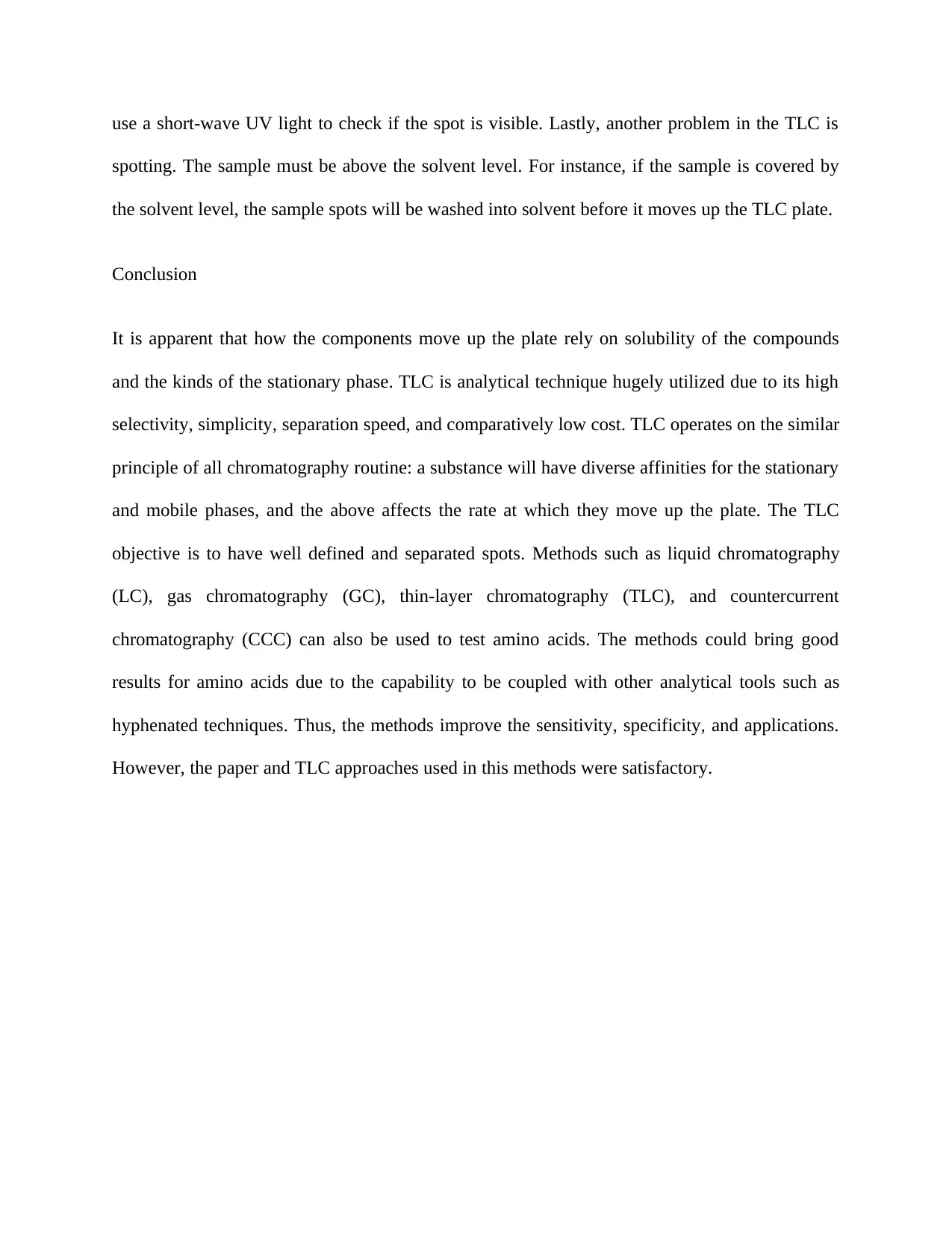
use a short-wave UV light to check if the spot is visible. Lastly, another problem in the TLC is
spotting. The sample must be above the solvent level. For instance, if the sample is covered by
the solvent level, the sample spots will be washed into solvent before it moves up the TLC plate.
Conclusion
It is apparent that how the components move up the plate rely on solubility of the compounds
and the kinds of the stationary phase. TLC is analytical technique hugely utilized due to its high
selectivity, simplicity, separation speed, and comparatively low cost. TLC operates on the similar
principle of all chromatography routine: a substance will have diverse affinities for the stationary
and mobile phases, and the above affects the rate at which they move up the plate. The TLC
objective is to have well defined and separated spots. Methods such as liquid chromatography
(LC), gas chromatography (GC), thin-layer chromatography (TLC), and countercurrent
chromatography (CCC) can also be used to test amino acids. The methods could bring good
results for amino acids due to the capability to be coupled with other analytical tools such as
hyphenated techniques. Thus, the methods improve the sensitivity, specificity, and applications.
However, the paper and TLC approaches used in this methods were satisfactory.
spotting. The sample must be above the solvent level. For instance, if the sample is covered by
the solvent level, the sample spots will be washed into solvent before it moves up the TLC plate.
Conclusion
It is apparent that how the components move up the plate rely on solubility of the compounds
and the kinds of the stationary phase. TLC is analytical technique hugely utilized due to its high
selectivity, simplicity, separation speed, and comparatively low cost. TLC operates on the similar
principle of all chromatography routine: a substance will have diverse affinities for the stationary
and mobile phases, and the above affects the rate at which they move up the plate. The TLC
objective is to have well defined and separated spots. Methods such as liquid chromatography
(LC), gas chromatography (GC), thin-layer chromatography (TLC), and countercurrent
chromatography (CCC) can also be used to test amino acids. The methods could bring good
results for amino acids due to the capability to be coupled with other analytical tools such as
hyphenated techniques. Thus, the methods improve the sensitivity, specificity, and applications.
However, the paper and TLC approaches used in this methods were satisfactory.
1 out of 7
Related Documents
Your All-in-One AI-Powered Toolkit for Academic Success.
+13062052269
info@desklib.com
Available 24*7 on WhatsApp / Email
![[object Object]](/_next/static/media/star-bottom.7253800d.svg)
Unlock your academic potential
© 2024 | Zucol Services PVT LTD | All rights reserved.
